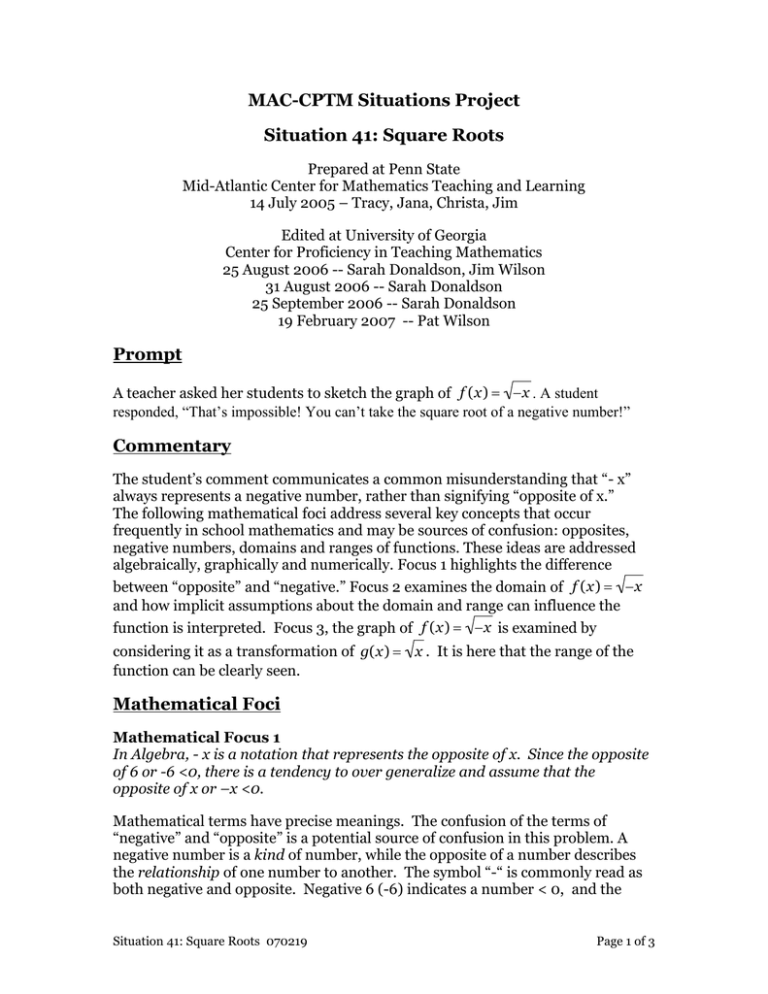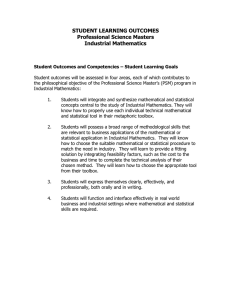MAC-CPTM Situations Project Situation 41: Square Roots
advertisement

MAC-CPTM Situations Project Situation 41: Square Roots Prepared at Penn State Mid-Atlantic Center for Mathematics Teaching and Learning 14 July 2005 – Tracy, Jana, Christa, Jim Edited at University of Georgia Center for Proficiency in Teaching Mathematics 25 August 2006 -- Sarah Donaldson, Jim Wilson 31 August 2006 -- Sarah Donaldson 25 September 2006 -- Sarah Donaldson 19 February 2007 -- Pat Wilson Prompt A teacher asked her students to sketch the graph of f (x) x . A student responded, “That’s impossible! You can’t take the square root of a negative number!” Commentary The student’s comment communicates a common misunderstanding that “- x” always represents a negative number, rather than signifying “opposite of x.” The following mathematical foci address several key concepts that occur frequently in school mathematics and may be sources of confusion: opposites, negative numbers, domains and ranges of functions. These ideas are addressed algebraically, graphically and numerically. Focus 1 highlights the difference between “opposite” and “negative.” Focus 2 examines the domain of f (x) x and how implicit assumptions about the domain and range can influence the function is interpreted. Focus 3, the graph of f (x) x is examined by the range of the considering it as a transformation of g(x) x . It is here that function can be clearly seen. Mathematical Foci Mathematical Focus 1 In Algebra, - x is a notation that represents the opposite of x. Since the opposite of 6 or -6 <0, there is a tendency to over generalize and assume that the opposite of x or –x <0. Mathematical terms have precise meanings. The confusion of the terms of “negative” and “opposite” is a potential source of confusion in this problem. A negative number is a kind of number, while the opposite of a number describes the relationship of one number to another. The symbol “-“ is commonly read as both negative and opposite. Negative 6 (-6) indicates a number < 0, and the Situation 41: Square Roots 070219 Page 1 of 3 number opposite of +6 (-6) indicates the additive inverse of +6. When we use x to represent a number, we do not indicate the kind of number (e.g. positive, negative, zero) and –x represents the opposite or additive inverse of x. Words are critical, both for mathematical accuracy and to avoid misconceptions. Mathematical Focus 2 The domain of the function f (x) x is critical in determining where the function is defined and in determining a particular value of the function if it exists. Often in school curricula, it is assumed that the domain and range of a function are restricted to real numbers. This implicit assumption contributes to the statement “You can’t take the square root of a negative number.” If the range and domain of f (x) x are restricted such that f (x), x R, the function is defined only for x 0 . If the range and domain of f (x) x 2 are restricted such that f (x), x R, the function is defined only for x 2 . If the domain includes all real the function is defined within the set numbers and the range is not restricted, of complex numbers. A numerical approach highlights the importance of the restrictions on x in determining where f (x) x is defined x x -4 (4) 2 -3 (3) 3 -2 (2) 2 -1 (1) 1 0 0 0 1 1 i 2 2 i 2 3 3 i 3 4 4 2i The resultsshow that f (x) x exists. If x 0 , the radicand 0 and f (x) is defined over the real numbers. If x 0 , the radicand < 0 and f (x) is an imaginary number. Mathematical Focus 3 Using a transformation of the graph of the known function g(x) x , the less familiar function, f (x) x , can be generated. Situation 41: Square Roots 070219 Page 2 of 3 We will restrict this discussion to functions defined within the real numbers. Specifically, the graph of the function f (x) x is a reflection of the graph of g(x) x about the vertical axis, as is shown in the following figure. 10 8 6 4 f x = g x = -x x 2 -10 -5 5 10 -2 The graph illustrates that f (x) x does exist, and that its domain is x ≤ 0. The range of f (x) is the same as that of g(x). That is, f (x) 0 . Situation 41: Square Roots 070219 Page 3 of 3


